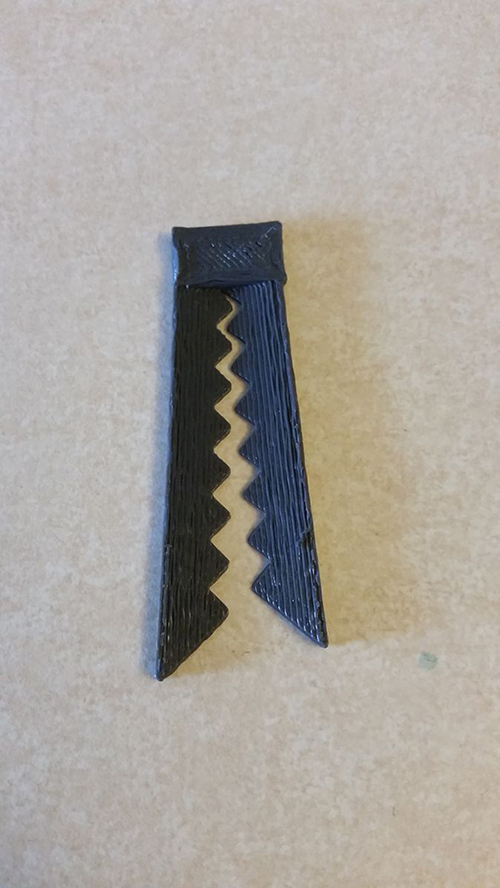Jayantchalke (talk | contribs) |
Jayantchalke (talk | contribs) |
||
| Line 13: | Line 13: | ||
Open source 3D Printing of these devices is a boon to the people in developing countries where they can print the devices and directly use in the clinics. | Open source 3D Printing of these devices is a boon to the people in developing countries where they can print the devices and directly use in the clinics. | ||
This OpenSource Appropriate Technology used in Manufacturing Umbilical Cord Clamp is one such step in providing a relatively cheap and quick access to the medical devices in developing countries. | This OpenSource Appropriate Technology used in Manufacturing Umbilical Cord Clamp is one such step in providing a relatively cheap and quick access to the medical devices in developing countries. | ||
3D printing of Umbilical Cord clamps was initiated by Ashley Dara in Haiti where she | 3D printing of Umbilical Cord clamps was initiated by Ashley Dara in Haiti where she has empowered local Haitians with the power of 3D printer and skilled them with Opensource 3D modelling software to design and explore various potentials of 3D printing opportunities in their surroundings. | ||
[[image:Umbilical Cord Clamp.jpeg|3D Printed Umbilical Cord CLamp|500px|right|3D Printed Umbilical Cord Clamp]] | [[image:Umbilical Cord Clamp.jpeg|3D Printed Umbilical Cord CLamp|500px|right|3D Printed Umbilical Cord Clamp]] | ||
Revision as of 23:47, 3 December 2014
'
Umbilical Cord Clamps
Project developed by User:Jayantchalke
Template:Statusboxtop Template:Status-design Template:Status-prototype You can help Appropedia by contributing to the next step in this OSAT's status. Template:Boxbottom
Abstract
Many times people in the developing countries are faced the problem of accessing medical devices due to the unavailability/ shortage of the device or the inefficient and corrupt local import systems [1] Open source 3D Printing of these devices is a boon to the people in developing countries where they can print the devices and directly use in the clinics. This OpenSource Appropriate Technology used in Manufacturing Umbilical Cord Clamp is one such step in providing a relatively cheap and quick access to the medical devices in developing countries. 3D printing of Umbilical Cord clamps was initiated by Ashley Dara in Haiti where she has empowered local Haitians with the power of 3D printer and skilled them with Opensource 3D modelling software to design and explore various potentials of 3D printing opportunities in their surroundings.

Bill of Materials
- PLA Filament ~ 22$ [2]
- Painters Tape/ Washable Glue/ Sharp Knife
Source Code Files
Tools needed for fabrication of the OSAT
- MOST Delta RepRap or similar RepRap 3-D printer
Skills and Knowledge Necessary to Make the OSAT
- MY4777/MY5777/EE4777/EE5777: Open-source 3-D printing.
- OpenSCAD
- CURA
Technical Specifications and Assembly Instructions
- It takes about 30 minutes to print out the clamp
- STL file provided could be used for printing as it is. If the design somewhat needs changes as the user requires could be accessed through the provide SCAD file. The major features of the clamp are numbered as per the schematic that could be traced in the SCAD file to edit specific features.
- After printing, clean the extra hanging plastic threads near the finger grips with a sharp knife
- Snap fit tightly the ends of the clamp in order to clamp it
| Example video summary of textbook |
|---|
Error in widget YouTube: Unable to load template 'wiki:YouTube' |
Common Problems and Solutions
- If the locking end of the Clamp does not print out well, it could be adjusted by heating it just a bit and flattening it.
Cost savings
- A commercially available clamp cost about 1.97$ [3]
- Where as a 3D printed clamp would cost about 0.28 $
- This accounts for savings worth 1.69$ or 85.76%
References
- The sources of information (e.g. engineering handbooks, journal articles, government documents, webpages, books, magazine articles etc.). References should use the <ref> </ref> and <references/> tags and can be in any format but should include all the information necessary for someone else to find the same information you did. For example: [1]
- ↑ web page: Department of Energy (DOE) Landscaping and Energy Efficiency, DOE/GO-10095 (1995) Available: http://www.eren.doe.gov/erec/factsheets/landscape.html
Based on the developmental needs addressed (e.g. food, heat, electricity, clean water, health care, etc.) be sure to label your device in the proper categories e.g. use [[Category:Water]]. Be sure to categorize your device so that it will be easy to find – for example “Low voltage connection basics” is categorized in [[Category:How tos]] [[Category:Electricity]] [[Category:Electric lighting]].
[[Category:]] [[Category:]]